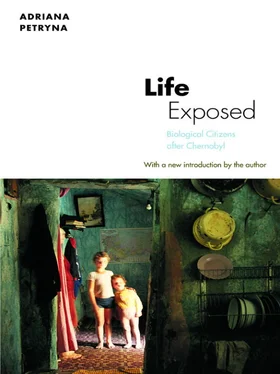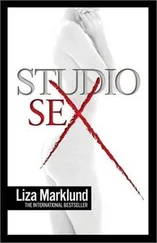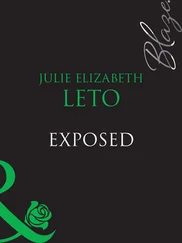Legislators (many of whom had had roles in the Soviet administration as its dissidents, cleanup workers, and implementers) viewed their political alliance as an opportunity to quickly do away with central power. This was especially true of well-organized Ukrainian Communist elites who, after much of the initial symbolic power of anti-Soviet nationalist groups such as Rukh had waned, rose to central prominence. [32] There are over twenty political parties in Ukraine. They include the Communist, Socialist, and the Socialist Party-Peasant Party on the left, to the Hromada, the Greens, and the Democratic Party in the center, to the nationalistic Rukh and National Front, to the far right UNA. For an account of the short-lived alliance, see Torbakov 2000. For an account of the relatively short-lived relationship between environmental movements and independence politics, see Dawson 1996.
In this moment of nation building, one could observe how bioscientific knowledge became a crucial medium in state-building processes and in the establishment of new policies guaranteeing safe living, social equity, and human rights. Legislators assailed the Soviet standard for determining biological risk to populations. The Soviets had established a high 35 rem spread over an individual’s lifetime (understood as a standard seventy-year span) as the threshold of allowable radiation dose intakes. [33] Throughout the book, I refer to the rem, the gray, and the mSv (milliSievert). The rem is a unit of equivalent dose for biological damage. Another such unit is the Sievert (Sv), where 1 Sv = 100 rem. The gray (Gy) is a unit of absorbed dose. A group of scientists working in the damaged reactor building over several years may have accumulated doses in the range of 0.5 to 13 grays (approximately 500 to 13,000 Sv, or 50 to 1,300 rem).
This threshold restricted the scope of resettlement actions. Ukrainian law lowered the threshold dose to 7 rem, comparable to what an average American would be exposed to in his or her lifetime. In effect this lowered measure for safe living increased the size of the labor forces going to the Zone (since workers’ stints had to be shortened if they were to avoid exceeding the stricter dose standards). The change also expanded the territory considered contaminated. A significant new sector of the population would want to claim itself as part of a state-protected post-Soviet polity. One radiation protection specialist, who conducted retrospective dose assays on resettlers, recollected: “Long lines of resettlers extended from our laboratory doors. It wasn’t enough that they were evacuated to ‘clean’ areas. People got entangled in the category of victim, by law. They had unpredictable futures and they all wanted to know their dose .”
The laws also made the “normal citizen” financially liable for the sufferer. A 12 percent tax was automatically deducted from the income of private businesses and state enterprises to fund Chernobyl laws on social protection. Such financial and moral obligations were meant to create a national bond—where otherwise there might not have been one—between sufferers and nonsufferers. Put another way, the Ukrainian laws attempted to “settle accounts” with the deleterious Soviet past, a retributive process first outlined by John Borneman in East-Central Europe (1997). The Ukrainian process was not about retribution per se, a process whereby people are rewarded or punished for past deeds; it was about compensation ( kompensatsiia ). Ukrainian administrators, many of whom had managed the Soviet containment of Chernobyl, were now authorizing payments on behalf of the state to those who claimed damages. These administrators did not thereby suffer any losses of employment or prestige, a key feature in retributive processes; in fact, many of them materially benefited from those processes by claiming material and physical damages themselves. The laws they implemented went beyond the goal of adding predictability to a democratizing process through retribution (ibid.). They inscribed Chernobyl as a key moral, economic, and political event in daily postsocialist Ukrainian life. They also fostered new appropriations (and misappropriations) of the law in the context of social and economic upheaval; compensation as a form of payment for past damage was reinterpreted as a form of market compensation.
With the lowered dose standard, more and more people became active participants in a system of compensation and social protections. State statistics registered sharp increases, starting in 1991, of Zone workers, resettled persons, and inhabitants of contaminated territories registering their disability, and in this new population’s annual patterns of enrollment. Such social statistics became a kind of “moral science” (Hacking 1991) through which the government revealed the effects of prior mismanagement and guaranteed its own social legitimacy while keeping world attention on Chernobyl-related risk.
Injured workers, resettled families, physicians, scientists, lawmakers, and local civil servants were increasingly bound together through law. And together, they constituted a set of public interests in which state and civil society negotiated a new social contract based on a right to know and “safe living.” Though the laws addressed a broad constituency, they were selectively applied, and “every one knew that.” The fight for disability status became the source of new solidarities and tensions. As the market economy took over, access to state protections and benefits became restricted. Persons claiming injury and the arbiters of those claims became consumed in public dramas over who had right of access to a system of compensation and social protections.
The state’s social welfare system expanded rather than contracted in order to accommodate the large influx of new Chernobyl sufferers. This rapid expansion defied Western prescriptions for a smooth transition to market economics—prescriptions that mandated a decrease in the social expenditures of the state. Sufferers became knowing participants in the logics of this transitional state expansion. These everyday events constituted a moral microcosm of the paradoxes of an emerging democracy founded on ethical principles of justice, benevolence, and human rights. If, on the one hand, these Chernobyl laws engendered new and demonstrably democratic forms of civic organizing and opportunities for nongovernmental action, on the other hand, they became one of the state’s most notorious mechanisms of corruption, one through which blat , for example (a term denoting the informal practice by which access to state privileges and protections could be obtained with connections or material resources), could persist (Ledeneva 1998).
As the everyday experience of Ukraine’s citizens—sufferers and non-sufferers alike—demonstrates, the Chernobyl aftermath is by no means a phenomenon confined to the past, interpretable as mere psychological trauma, or reducible in terms of scientific absolutes. Rather, it is a dynamic lens for understanding the role of science, economics, ethics, and politics in the arrangement of a postsocialist civil society. Fields as diverse as radiobiology, health physics, molecular biology, neurology, neuropsychiatry, and social psychology contribute to the aftermath’s data-producing enterprise. These sciences define, quantify, psychologize, biologize, and geneticize; their isolated facts can thus obscure the aftermath’s more general dimensions. From an anthropological standpoint, scientific facts become significant in terms of how, in their partiality, they become incorporated into an ongoing struggle for life, understood here as a complex and often painful interplay between technical visions for managing the accident’s effects and lived individual and social disturbances. The vitality of the aftermath’s knowledge-production arises from the changing dynamic between the known and the unknown, and the complex ways that people become incorporated into it as subjects, objects, proxies, agents, and victims.
Читать дальше












